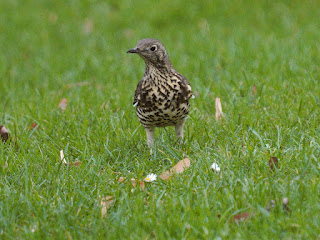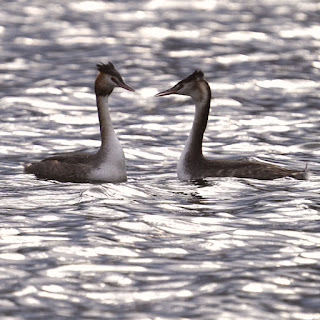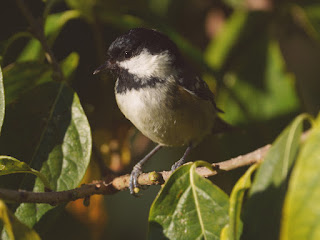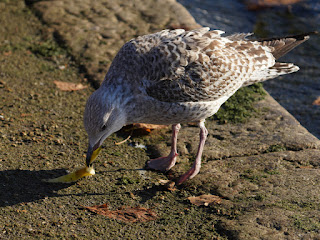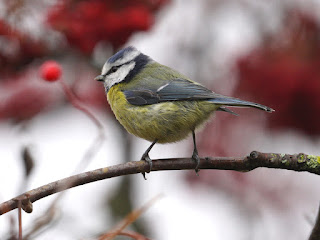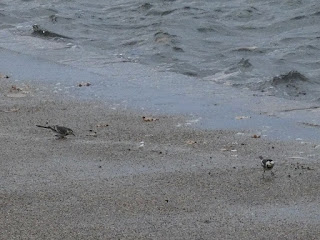Tuesday, 30 November 2021
Monday, 29 November 2021
The confident Coal Tit in the Flower Walk followed me along the path taking pine nuts from my hand.
A Jay was waiting to fly down and grab a peanut from my fingers.
A Long-Tailed Tit perched in an American oak near the leaf yard.
The Mistle Thrush in the rowan tree on Buck Hill was looking militant ...
... because it had just chased this Jay on to an upper branch.
There was also a Magpie in the tree, which the thrush hadn't dealt with. But these fierce birds do attack Magpies in the nesting season, so it was quite up to the contest.
Another Magpie rummaged in autumn leaves looking for insects and worms.
A visit to the Rose Garden found nothing more exotic than the local Robin ...
... and a Great Tit.
The Rose-Ringed Parakeets, so well hidden in the leaves in summer, are now glaringly exposed. They are predated by Tawny Owls, Sparrowhawks and Peregrines, and once Paul saw a Hobby eating one -- you would have thought Hobbies are too small to take them on.
A fine seasonal picture by Neil of leaves being cleared by a tractor-mounted blower.
This year the Kensington Gardens staff are trying a new technique. On the open lawns the leaves are not being collected, but are being chopped up by running the two mowing machines over them and left to lie, where they will rot and fertilise the grass. It saves a lot of labour in taking leaves to the leaf yard, composting them, and bringing the resulting leafmould back. They are also, to my great relief, not blowing leaves out of the shrubberies and so depriving Blackbirds and other thrushes of their foraging grounds. (This is mainly because, for 'green' reasons, they have been deprived of their petrol-driven blowers and issued with electric ones that couldn't blow the skin off a rice pudding.) But it can't be a complete solution, as leaves build up thickly in some places and still have to be collected.
A Grey Wagtail looked for insects in fallen leaves frozen into a thin layer of ice on the Serpentine.
A Carrion Crow washed on the dead willow near the Italian Garden ...
... climbed higher up the branch ...
... and shook itself dry.
The pigeon-eating Lesser Black-Backed Gull was in his usual place at the Dell restaurant preening his immaculate plumage. This picture clearly shows the remarkably deep yellow colour of his bill and feet, which I think is due to his rich diet. The colour comes from astaxanthin, a carotenoid pigment found in meat and fat. (It's also responsible for the yellow feathers of the Great Tit above; the bird gets it from insects.)
A Cormorant jumped on to a chain at the island and struggled for balance.
Sunday, 28 November 2021
The one and only Mistle Thrush on Buck Hill waited in a plane tree for a visit to eat rowan fruit. Even when they aren't in a flock they have this habit of making a quick raid on a fruit tree and then flying away to digest their pickings. Maybe this behaviour makes them less exposed to predators that might be watching the fruit tree.
However, when it landed it found a Magpie on another branch. It glanced round nervously.
The female Chaffinch in the Flower Walk is getting very familiar and nearly came to Neil's hand. Several years ago there was a Chaffinch in the leaf yard that could be hand fed.
There is no difficulty in hand feeding the confident Coal Tit. Indeed, it follows you along the path asking for more.
A Long-Tailed Tit was backlit in the bushes near Peter Pan.
The Grey Wagtail on the Serpentine found a small larva in the fallen leaves.
A pair of Carrion Crows perched in the top of a twisty tree near the Italian Garden.
Crows ate the remains of the pigeon-eating Lesser Black-Backed Gull's breakfast. He had had enough, and let them get on with it. He is getting milder as he ages -- except towards pigeons.
The sunlight made a rainbow in a fountain in the Italian Garden.
Behind it, a Grey Heron stood on the edge of a pool. Herons are usually very shy birds, but the ones in the park are accustomed to humans and take no notice of them unless they seem to have food. (And yes, I did ask the parents of the little girl if I could show this video.)
The heron at the Dell restaurant looked up eagerly as some people arrived at a table on the terrace.
Several young Herring Gulls in turn picked up a banana skin, decided it wasn't good to eat, and dropped it.
A young Cormorant gazed severely at a pair of Moorhens on the little island in the Long Water.
A Moorhen at the edge of the Serpentine looked rather fine in the low winter sunshine.
The two young Great Crested Grebes on the Long Water hung out together. They are now completely independent, and when their parent caught a fish in the background they didn't react.
Pochards appear and disappear on the Long Water. I think they're always there, but spend a lot of their time hidden in the bushes. Once this autumn I counted 21 of them, but have never seen as many again. Often you see none at all.
Saturday, 27 November 2021
The stormy wind is still blowing, and chilly drizzle made it a horrible day. But the single Mistle Thrush on Buck Hill -- the autumn migrants still haven't reach the park -- was in a hawthorn tree.
The Blackbirds have eaten all the hawthorn berries, so it flew to the nearby rowan. I was making it nervous, so it wouldn't eat the fruit till I went away and left it in peace.
There was also a Blue Tit in the rowan, looking for insects among the berries.
A small flock of Long-Tailed Tits were chasing each other around an oak tree lower down the hill. One stayed still for just long enough for a quick shot.
Neil also found a Blue Tit ...
... and a Great Tit among the violent violet berries on a Beautyberry bush in the Flower Walk.
Another pleasing picture by Neil, of a female Chaffinch on one of the yew hedges in the walk.
The Grey Wagtail that lives on the Serpentine was on the island. It's exceptionally well camouflaged and I only saw it because it was calling.
Then it moved to the east end of the lake and ran along the edge of the surf looking for small edible creatures washed ashore.
There was a pair of Pied Wagtails at the edge of the Round Pond.
They were searching for food in the spray carried ashore by the waves, though they could hardly keep their footing in the wind.
A Magpie looked for food in a bin at the Diana fountain, found none because there were few people in the park, and relieved its disappointment by pecking at the plastic liner.
A Grey Heron at the island stoically endured the wind and rain on a post ...
... but the young one at the Vista took shelter behind the Henry Moore sculpture.
A pair of Herring Gulls moaned affectionately, waved leaves at each other, and went around together on the edge of the Serpentine. We've seen this pair before, always devoted to each other.
The Polish Black-Headed Gull T4UN, who crosses the stormy North Sea twice a year, wasn't bothered by the weather ...
... but a Mute Swan, tired of being bounced around on the waves, came ashore to rest.
